Tesco PLC: Strategic Planning, Analysis, and Implementation
VerifiedAdded on 2024/04/26
|23
|6323
|98
Report
AI Summary
This report provides a comprehensive analysis of Tesco PLC's business strategy, covering key aspects such as the influence of mission, vision, objectives, goals, and core competencies on strategic planning. It examines internal and external factors, including global economies, cultural diversities, and brand awareness, that shape Tesco's strategic plans. The report evaluates the effectiveness of techniques like the BCG Matrix in developing business strategies, highlighting Tesco's adaptability as a 'star' or 'cash cow' based on market conditions. Furthermore, it includes organizational and environmental audits, assessing strengths, weaknesses, opportunities, and threats. The analysis extends to stakeholder needs and proposes a new strategy for Tesco PLC, considering alternative strategies for market entry, growth, and retrenchment. Finally, the report assesses the roles and resource requirements for implementing the proposed strategy, emphasizing the contribution of SMART targets to achieving strategic goals. The document is contributed by a student and available on Desklib, a platform that provides study tools for students.
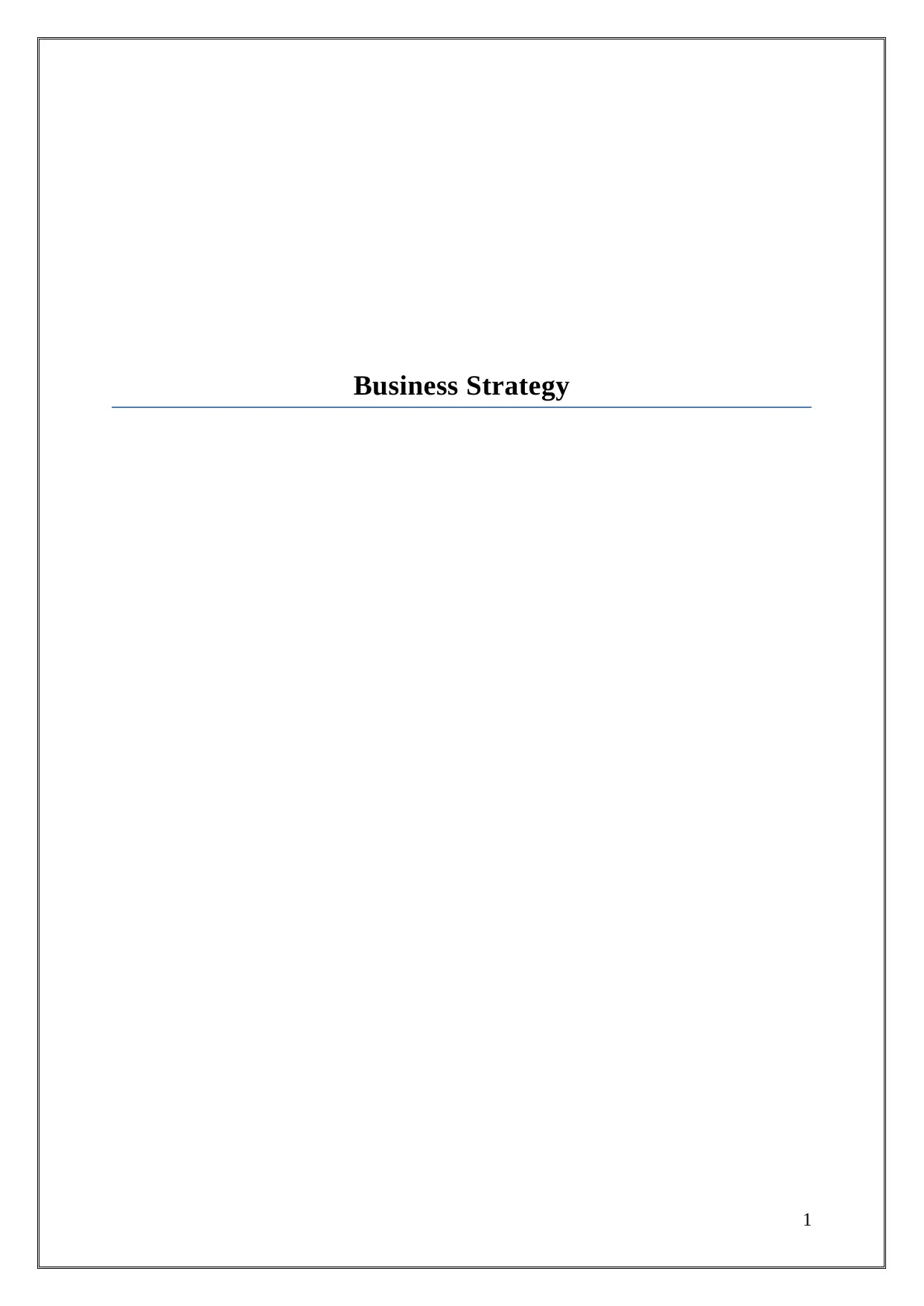
Business Strategy
1
1
Paraphrase This Document
Need a fresh take? Get an instant paraphrase of this document with our AI Paraphraser
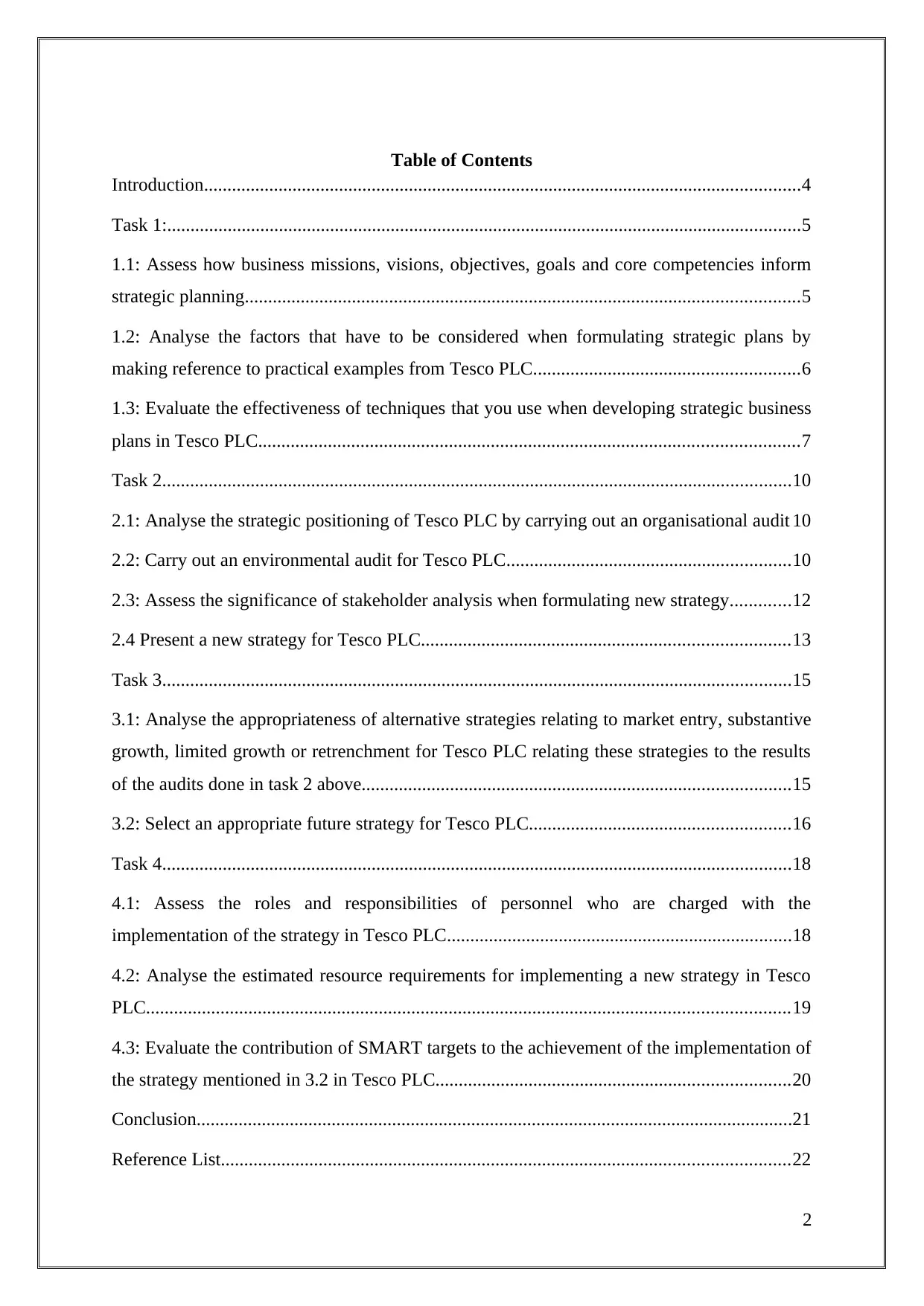
Table of Contents
Introduction................................................................................................................................4
Task 1:........................................................................................................................................5
1.1: Assess how business missions, visions, objectives, goals and core competencies inform
strategic planning.......................................................................................................................5
1.2: Analyse the factors that have to be considered when formulating strategic plans by
making reference to practical examples from Tesco PLC.........................................................6
1.3: Evaluate the effectiveness of techniques that you use when developing strategic business
plans in Tesco PLC....................................................................................................................7
Task 2.......................................................................................................................................10
2.1: Analyse the strategic positioning of Tesco PLC by carrying out an organisational audit 10
2.2: Carry out an environmental audit for Tesco PLC.............................................................10
2.3: Assess the significance of stakeholder analysis when formulating new strategy.............12
2.4 Present a new strategy for Tesco PLC...............................................................................13
Task 3.......................................................................................................................................15
3.1: Analyse the appropriateness of alternative strategies relating to market entry, substantive
growth, limited growth or retrenchment for Tesco PLC relating these strategies to the results
of the audits done in task 2 above............................................................................................15
3.2: Select an appropriate future strategy for Tesco PLC........................................................16
Task 4.......................................................................................................................................18
4.1: Assess the roles and responsibilities of personnel who are charged with the
implementation of the strategy in Tesco PLC..........................................................................18
4.2: Analyse the estimated resource requirements for implementing a new strategy in Tesco
PLC..........................................................................................................................................19
4.3: Evaluate the contribution of SMART targets to the achievement of the implementation of
the strategy mentioned in 3.2 in Tesco PLC............................................................................20
Conclusion................................................................................................................................21
Reference List..........................................................................................................................22
2
Introduction................................................................................................................................4
Task 1:........................................................................................................................................5
1.1: Assess how business missions, visions, objectives, goals and core competencies inform
strategic planning.......................................................................................................................5
1.2: Analyse the factors that have to be considered when formulating strategic plans by
making reference to practical examples from Tesco PLC.........................................................6
1.3: Evaluate the effectiveness of techniques that you use when developing strategic business
plans in Tesco PLC....................................................................................................................7
Task 2.......................................................................................................................................10
2.1: Analyse the strategic positioning of Tesco PLC by carrying out an organisational audit 10
2.2: Carry out an environmental audit for Tesco PLC.............................................................10
2.3: Assess the significance of stakeholder analysis when formulating new strategy.............12
2.4 Present a new strategy for Tesco PLC...............................................................................13
Task 3.......................................................................................................................................15
3.1: Analyse the appropriateness of alternative strategies relating to market entry, substantive
growth, limited growth or retrenchment for Tesco PLC relating these strategies to the results
of the audits done in task 2 above............................................................................................15
3.2: Select an appropriate future strategy for Tesco PLC........................................................16
Task 4.......................................................................................................................................18
4.1: Assess the roles and responsibilities of personnel who are charged with the
implementation of the strategy in Tesco PLC..........................................................................18
4.2: Analyse the estimated resource requirements for implementing a new strategy in Tesco
PLC..........................................................................................................................................19
4.3: Evaluate the contribution of SMART targets to the achievement of the implementation of
the strategy mentioned in 3.2 in Tesco PLC............................................................................20
Conclusion................................................................................................................................21
Reference List..........................................................................................................................22
2
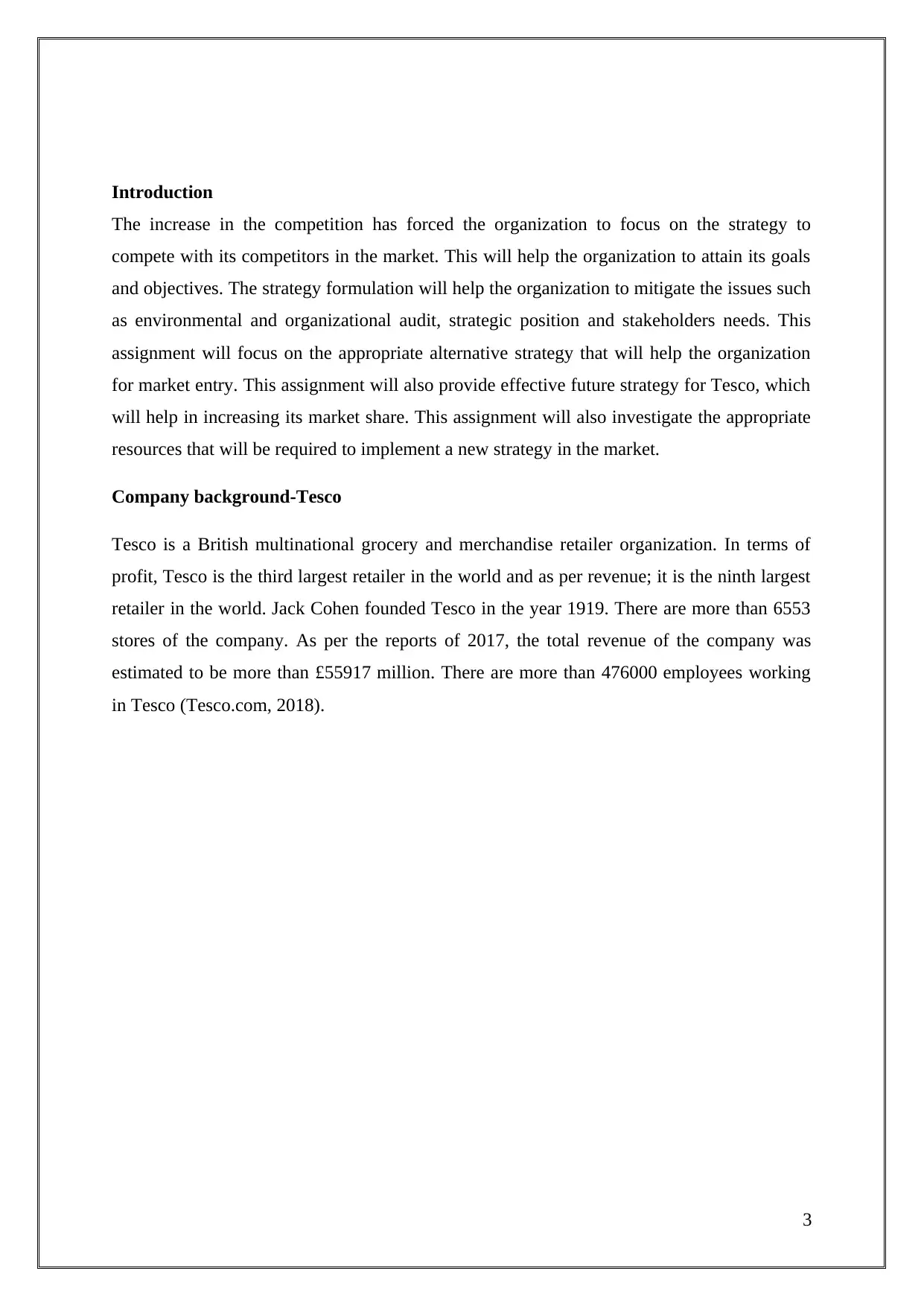
Introduction
The increase in the competition has forced the organization to focus on the strategy to
compete with its competitors in the market. This will help the organization to attain its goals
and objectives. The strategy formulation will help the organization to mitigate the issues such
as environmental and organizational audit, strategic position and stakeholders needs. This
assignment will focus on the appropriate alternative strategy that will help the organization
for market entry. This assignment will also provide effective future strategy for Tesco, which
will help in increasing its market share. This assignment will also investigate the appropriate
resources that will be required to implement a new strategy in the market.
Company background-Tesco
Tesco is a British multinational grocery and merchandise retailer organization. In terms of
profit, Tesco is the third largest retailer in the world and as per revenue; it is the ninth largest
retailer in the world. Jack Cohen founded Tesco in the year 1919. There are more than 6553
stores of the company. As per the reports of 2017, the total revenue of the company was
estimated to be more than £55917 million. There are more than 476000 employees working
in Tesco (Tesco.com, 2018).
3
The increase in the competition has forced the organization to focus on the strategy to
compete with its competitors in the market. This will help the organization to attain its goals
and objectives. The strategy formulation will help the organization to mitigate the issues such
as environmental and organizational audit, strategic position and stakeholders needs. This
assignment will focus on the appropriate alternative strategy that will help the organization
for market entry. This assignment will also provide effective future strategy for Tesco, which
will help in increasing its market share. This assignment will also investigate the appropriate
resources that will be required to implement a new strategy in the market.
Company background-Tesco
Tesco is a British multinational grocery and merchandise retailer organization. In terms of
profit, Tesco is the third largest retailer in the world and as per revenue; it is the ninth largest
retailer in the world. Jack Cohen founded Tesco in the year 1919. There are more than 6553
stores of the company. As per the reports of 2017, the total revenue of the company was
estimated to be more than £55917 million. There are more than 476000 employees working
in Tesco (Tesco.com, 2018).
3
⊘ This is a preview!⊘
Do you want full access?
Subscribe today to unlock all pages.

Trusted by 1+ million students worldwide
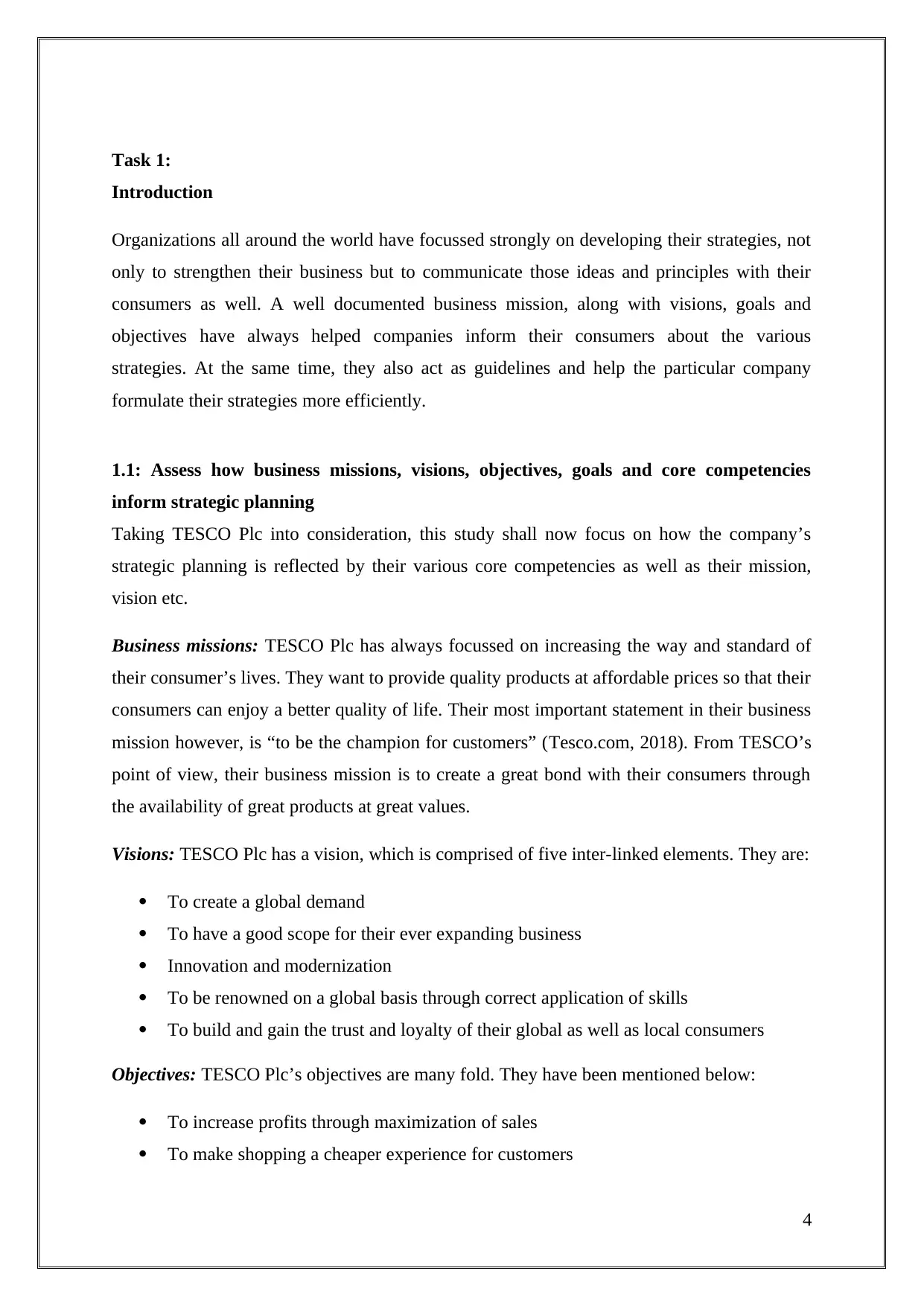
Task 1:
Introduction
Organizations all around the world have focussed strongly on developing their strategies, not
only to strengthen their business but to communicate those ideas and principles with their
consumers as well. A well documented business mission, along with visions, goals and
objectives have always helped companies inform their consumers about the various
strategies. At the same time, they also act as guidelines and help the particular company
formulate their strategies more efficiently.
1.1: Assess how business missions, visions, objectives, goals and core competencies
inform strategic planning
Taking TESCO Plc into consideration, this study shall now focus on how the company’s
strategic planning is reflected by their various core competencies as well as their mission,
vision etc.
Business missions: TESCO Plc has always focussed on increasing the way and standard of
their consumer’s lives. They want to provide quality products at affordable prices so that their
consumers can enjoy a better quality of life. Their most important statement in their business
mission however, is “to be the champion for customers” (Tesco.com, 2018). From TESCO’s
point of view, their business mission is to create a great bond with their consumers through
the availability of great products at great values.
Visions: TESCO Plc has a vision, which is comprised of five inter-linked elements. They are:
To create a global demand
To have a good scope for their ever expanding business
Innovation and modernization
To be renowned on a global basis through correct application of skills
To build and gain the trust and loyalty of their global as well as local consumers
Objectives: TESCO Plc’s objectives are many fold. They have been mentioned below:
To increase profits through maximization of sales
To make shopping a cheaper experience for customers
4
Introduction
Organizations all around the world have focussed strongly on developing their strategies, not
only to strengthen their business but to communicate those ideas and principles with their
consumers as well. A well documented business mission, along with visions, goals and
objectives have always helped companies inform their consumers about the various
strategies. At the same time, they also act as guidelines and help the particular company
formulate their strategies more efficiently.
1.1: Assess how business missions, visions, objectives, goals and core competencies
inform strategic planning
Taking TESCO Plc into consideration, this study shall now focus on how the company’s
strategic planning is reflected by their various core competencies as well as their mission,
vision etc.
Business missions: TESCO Plc has always focussed on increasing the way and standard of
their consumer’s lives. They want to provide quality products at affordable prices so that their
consumers can enjoy a better quality of life. Their most important statement in their business
mission however, is “to be the champion for customers” (Tesco.com, 2018). From TESCO’s
point of view, their business mission is to create a great bond with their consumers through
the availability of great products at great values.
Visions: TESCO Plc has a vision, which is comprised of five inter-linked elements. They are:
To create a global demand
To have a good scope for their ever expanding business
Innovation and modernization
To be renowned on a global basis through correct application of skills
To build and gain the trust and loyalty of their global as well as local consumers
Objectives: TESCO Plc’s objectives are many fold. They have been mentioned below:
To increase profits through maximization of sales
To make shopping a cheaper experience for customers
4
Paraphrase This Document
Need a fresh take? Get an instant paraphrase of this document with our AI Paraphraser
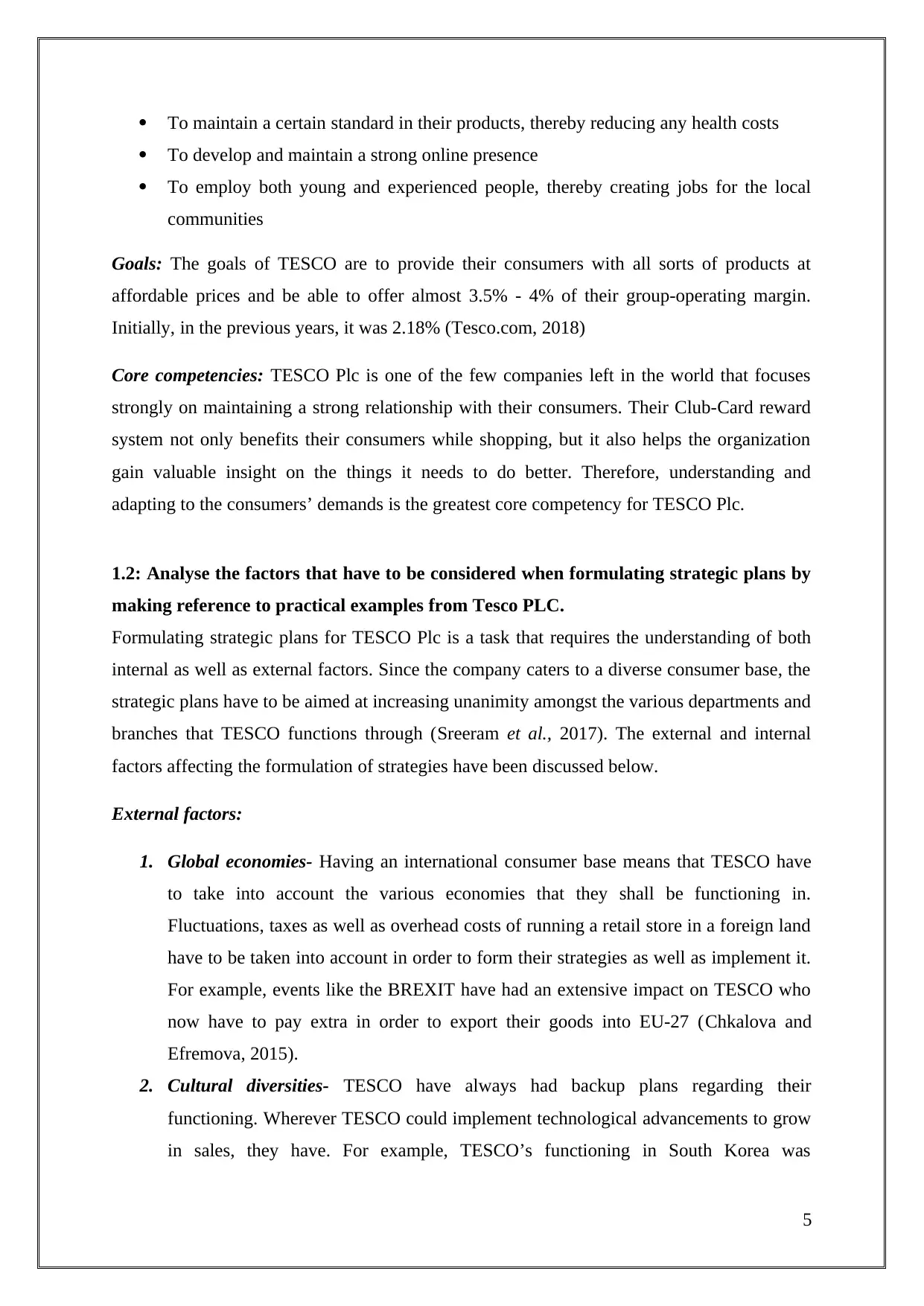
To maintain a certain standard in their products, thereby reducing any health costs
To develop and maintain a strong online presence
To employ both young and experienced people, thereby creating jobs for the local
communities
Goals: The goals of TESCO are to provide their consumers with all sorts of products at
affordable prices and be able to offer almost 3.5% - 4% of their group-operating margin.
Initially, in the previous years, it was 2.18% (Tesco.com, 2018)
Core competencies: TESCO Plc is one of the few companies left in the world that focuses
strongly on maintaining a strong relationship with their consumers. Their Club-Card reward
system not only benefits their consumers while shopping, but it also helps the organization
gain valuable insight on the things it needs to do better. Therefore, understanding and
adapting to the consumers’ demands is the greatest core competency for TESCO Plc.
1.2: Analyse the factors that have to be considered when formulating strategic plans by
making reference to practical examples from Tesco PLC.
Formulating strategic plans for TESCO Plc is a task that requires the understanding of both
internal as well as external factors. Since the company caters to a diverse consumer base, the
strategic plans have to be aimed at increasing unanimity amongst the various departments and
branches that TESCO functions through (Sreeram et al., 2017). The external and internal
factors affecting the formulation of strategies have been discussed below.
External factors:
1. Global economies- Having an international consumer base means that TESCO have
to take into account the various economies that they shall be functioning in.
Fluctuations, taxes as well as overhead costs of running a retail store in a foreign land
have to be taken into account in order to form their strategies as well as implement it.
For example, events like the BREXIT have had an extensive impact on TESCO who
now have to pay extra in order to export their goods into EU-27 (Chkalova and
Efremova, 2015).
2. Cultural diversities- TESCO have always had backup plans regarding their
functioning. Wherever TESCO could implement technological advancements to grow
in sales, they have. For example, TESCO’s functioning in South Korea was
5
To develop and maintain a strong online presence
To employ both young and experienced people, thereby creating jobs for the local
communities
Goals: The goals of TESCO are to provide their consumers with all sorts of products at
affordable prices and be able to offer almost 3.5% - 4% of their group-operating margin.
Initially, in the previous years, it was 2.18% (Tesco.com, 2018)
Core competencies: TESCO Plc is one of the few companies left in the world that focuses
strongly on maintaining a strong relationship with their consumers. Their Club-Card reward
system not only benefits their consumers while shopping, but it also helps the organization
gain valuable insight on the things it needs to do better. Therefore, understanding and
adapting to the consumers’ demands is the greatest core competency for TESCO Plc.
1.2: Analyse the factors that have to be considered when formulating strategic plans by
making reference to practical examples from Tesco PLC.
Formulating strategic plans for TESCO Plc is a task that requires the understanding of both
internal as well as external factors. Since the company caters to a diverse consumer base, the
strategic plans have to be aimed at increasing unanimity amongst the various departments and
branches that TESCO functions through (Sreeram et al., 2017). The external and internal
factors affecting the formulation of strategies have been discussed below.
External factors:
1. Global economies- Having an international consumer base means that TESCO have
to take into account the various economies that they shall be functioning in.
Fluctuations, taxes as well as overhead costs of running a retail store in a foreign land
have to be taken into account in order to form their strategies as well as implement it.
For example, events like the BREXIT have had an extensive impact on TESCO who
now have to pay extra in order to export their goods into EU-27 (Chkalova and
Efremova, 2015).
2. Cultural diversities- TESCO have always had backup plans regarding their
functioning. Wherever TESCO could implement technological advancements to grow
in sales, they have. For example, TESCO’s functioning in South Korea was
5
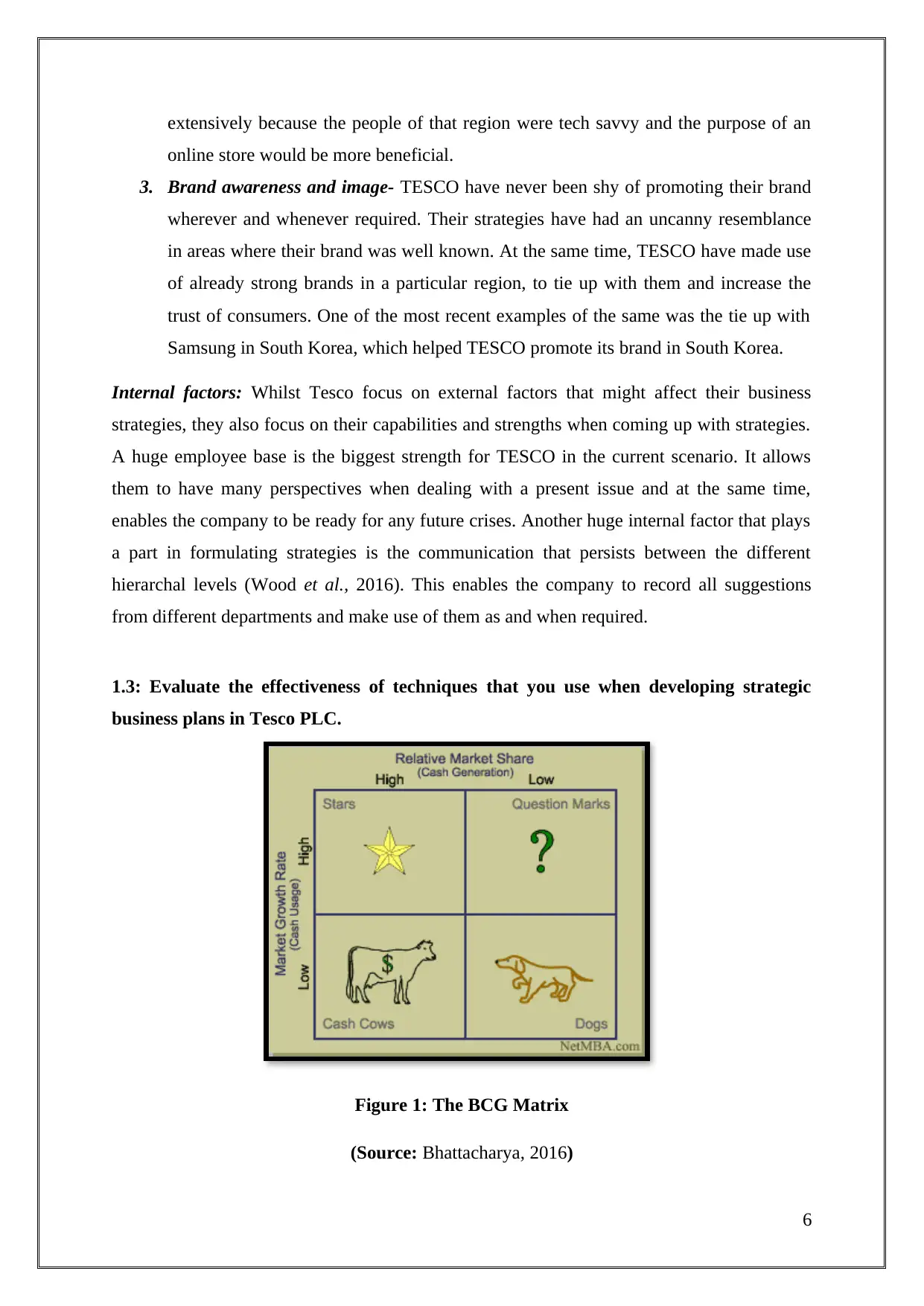
extensively because the people of that region were tech savvy and the purpose of an
online store would be more beneficial.
3. Brand awareness and image- TESCO have never been shy of promoting their brand
wherever and whenever required. Their strategies have had an uncanny resemblance
in areas where their brand was well known. At the same time, TESCO have made use
of already strong brands in a particular region, to tie up with them and increase the
trust of consumers. One of the most recent examples of the same was the tie up with
Samsung in South Korea, which helped TESCO promote its brand in South Korea.
Internal factors: Whilst Tesco focus on external factors that might affect their business
strategies, they also focus on their capabilities and strengths when coming up with strategies.
A huge employee base is the biggest strength for TESCO in the current scenario. It allows
them to have many perspectives when dealing with a present issue and at the same time,
enables the company to be ready for any future crises. Another huge internal factor that plays
a part in formulating strategies is the communication that persists between the different
hierarchal levels (Wood et al., 2016). This enables the company to record all suggestions
from different departments and make use of them as and when required.
1.3: Evaluate the effectiveness of techniques that you use when developing strategic
business plans in Tesco PLC.
Figure 1: The BCG Matrix
(Source: Bhattacharya, 2016)
6
online store would be more beneficial.
3. Brand awareness and image- TESCO have never been shy of promoting their brand
wherever and whenever required. Their strategies have had an uncanny resemblance
in areas where their brand was well known. At the same time, TESCO have made use
of already strong brands in a particular region, to tie up with them and increase the
trust of consumers. One of the most recent examples of the same was the tie up with
Samsung in South Korea, which helped TESCO promote its brand in South Korea.
Internal factors: Whilst Tesco focus on external factors that might affect their business
strategies, they also focus on their capabilities and strengths when coming up with strategies.
A huge employee base is the biggest strength for TESCO in the current scenario. It allows
them to have many perspectives when dealing with a present issue and at the same time,
enables the company to be ready for any future crises. Another huge internal factor that plays
a part in formulating strategies is the communication that persists between the different
hierarchal levels (Wood et al., 2016). This enables the company to record all suggestions
from different departments and make use of them as and when required.
1.3: Evaluate the effectiveness of techniques that you use when developing strategic
business plans in Tesco PLC.
Figure 1: The BCG Matrix
(Source: Bhattacharya, 2016)
6
⊘ This is a preview!⊘
Do you want full access?
Subscribe today to unlock all pages.

Trusted by 1+ million students worldwide
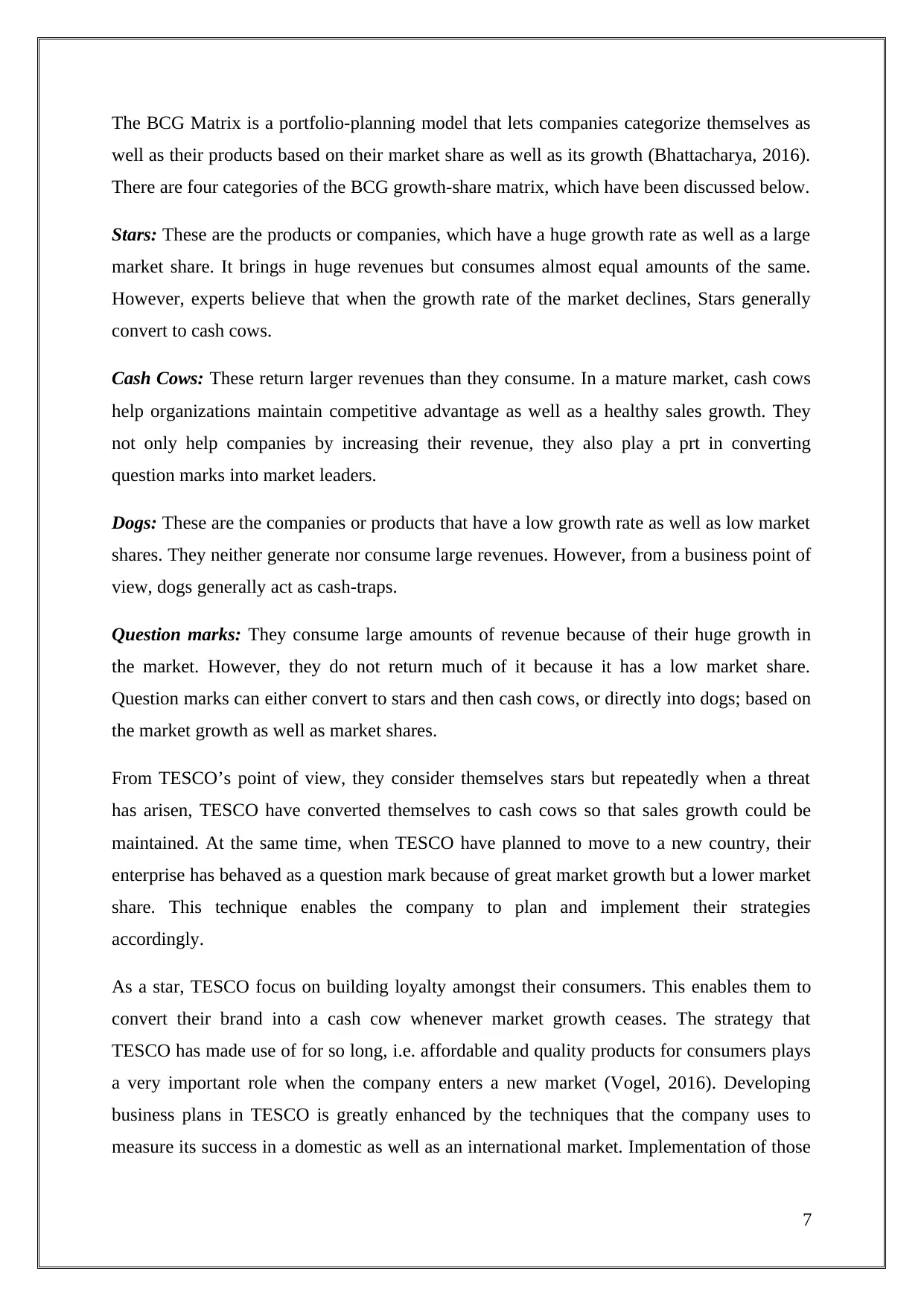
The BCG Matrix is a portfolio-planning model that lets companies categorize themselves as
well as their products based on their market share as well as its growth (Bhattacharya, 2016).
There are four categories of the BCG growth-share matrix, which have been discussed below.
Stars: These are the products or companies, which have a huge growth rate as well as a large
market share. It brings in huge revenues but consumes almost equal amounts of the same.
However, experts believe that when the growth rate of the market declines, Stars generally
convert to cash cows.
Cash Cows: These return larger revenues than they consume. In a mature market, cash cows
help organizations maintain competitive advantage as well as a healthy sales growth. They
not only help companies by increasing their revenue, they also play a prt in converting
question marks into market leaders.
Dogs: These are the companies or products that have a low growth rate as well as low market
shares. They neither generate nor consume large revenues. However, from a business point of
view, dogs generally act as cash-traps.
Question marks: They consume large amounts of revenue because of their huge growth in
the market. However, they do not return much of it because it has a low market share.
Question marks can either convert to stars and then cash cows, or directly into dogs; based on
the market growth as well as market shares.
From TESCO’s point of view, they consider themselves stars but repeatedly when a threat
has arisen, TESCO have converted themselves to cash cows so that sales growth could be
maintained. At the same time, when TESCO have planned to move to a new country, their
enterprise has behaved as a question mark because of great market growth but a lower market
share. This technique enables the company to plan and implement their strategies
accordingly.
As a star, TESCO focus on building loyalty amongst their consumers. This enables them to
convert their brand into a cash cow whenever market growth ceases. The strategy that
TESCO has made use of for so long, i.e. affordable and quality products for consumers plays
a very important role when the company enters a new market (Vogel, 2016). Developing
business plans in TESCO is greatly enhanced by the techniques that the company uses to
measure its success in a domestic as well as an international market. Implementation of those
7
well as their products based on their market share as well as its growth (Bhattacharya, 2016).
There are four categories of the BCG growth-share matrix, which have been discussed below.
Stars: These are the products or companies, which have a huge growth rate as well as a large
market share. It brings in huge revenues but consumes almost equal amounts of the same.
However, experts believe that when the growth rate of the market declines, Stars generally
convert to cash cows.
Cash Cows: These return larger revenues than they consume. In a mature market, cash cows
help organizations maintain competitive advantage as well as a healthy sales growth. They
not only help companies by increasing their revenue, they also play a prt in converting
question marks into market leaders.
Dogs: These are the companies or products that have a low growth rate as well as low market
shares. They neither generate nor consume large revenues. However, from a business point of
view, dogs generally act as cash-traps.
Question marks: They consume large amounts of revenue because of their huge growth in
the market. However, they do not return much of it because it has a low market share.
Question marks can either convert to stars and then cash cows, or directly into dogs; based on
the market growth as well as market shares.
From TESCO’s point of view, they consider themselves stars but repeatedly when a threat
has arisen, TESCO have converted themselves to cash cows so that sales growth could be
maintained. At the same time, when TESCO have planned to move to a new country, their
enterprise has behaved as a question mark because of great market growth but a lower market
share. This technique enables the company to plan and implement their strategies
accordingly.
As a star, TESCO focus on building loyalty amongst their consumers. This enables them to
convert their brand into a cash cow whenever market growth ceases. The strategy that
TESCO has made use of for so long, i.e. affordable and quality products for consumers plays
a very important role when the company enters a new market (Vogel, 2016). Developing
business plans in TESCO is greatly enhanced by the techniques that the company uses to
measure its success in a domestic as well as an international market. Implementation of those
7
Paraphrase This Document
Need a fresh take? Get an instant paraphrase of this document with our AI Paraphraser
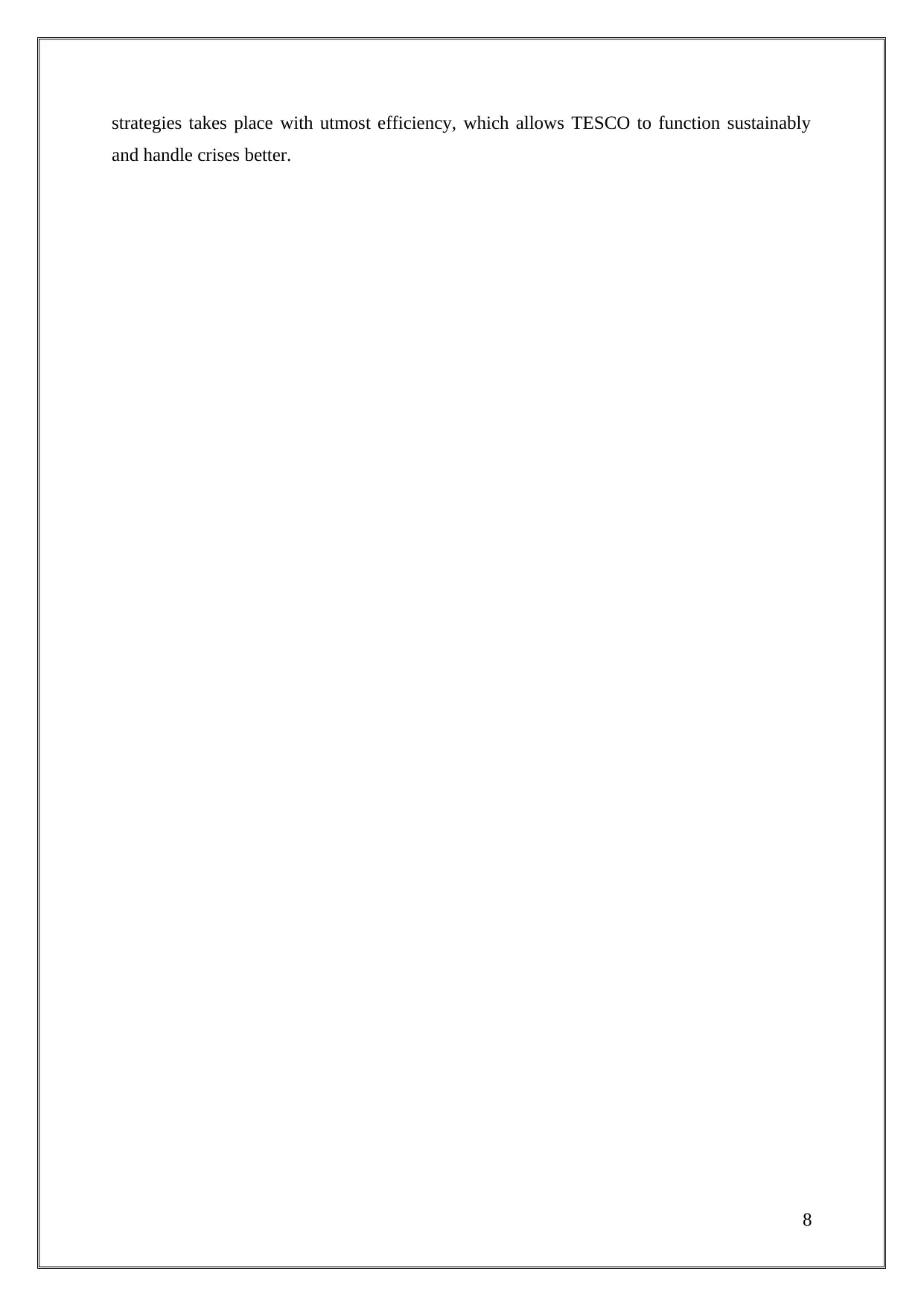
strategies takes place with utmost efficiency, which allows TESCO to function sustainably
and handle crises better.
8
and handle crises better.
8
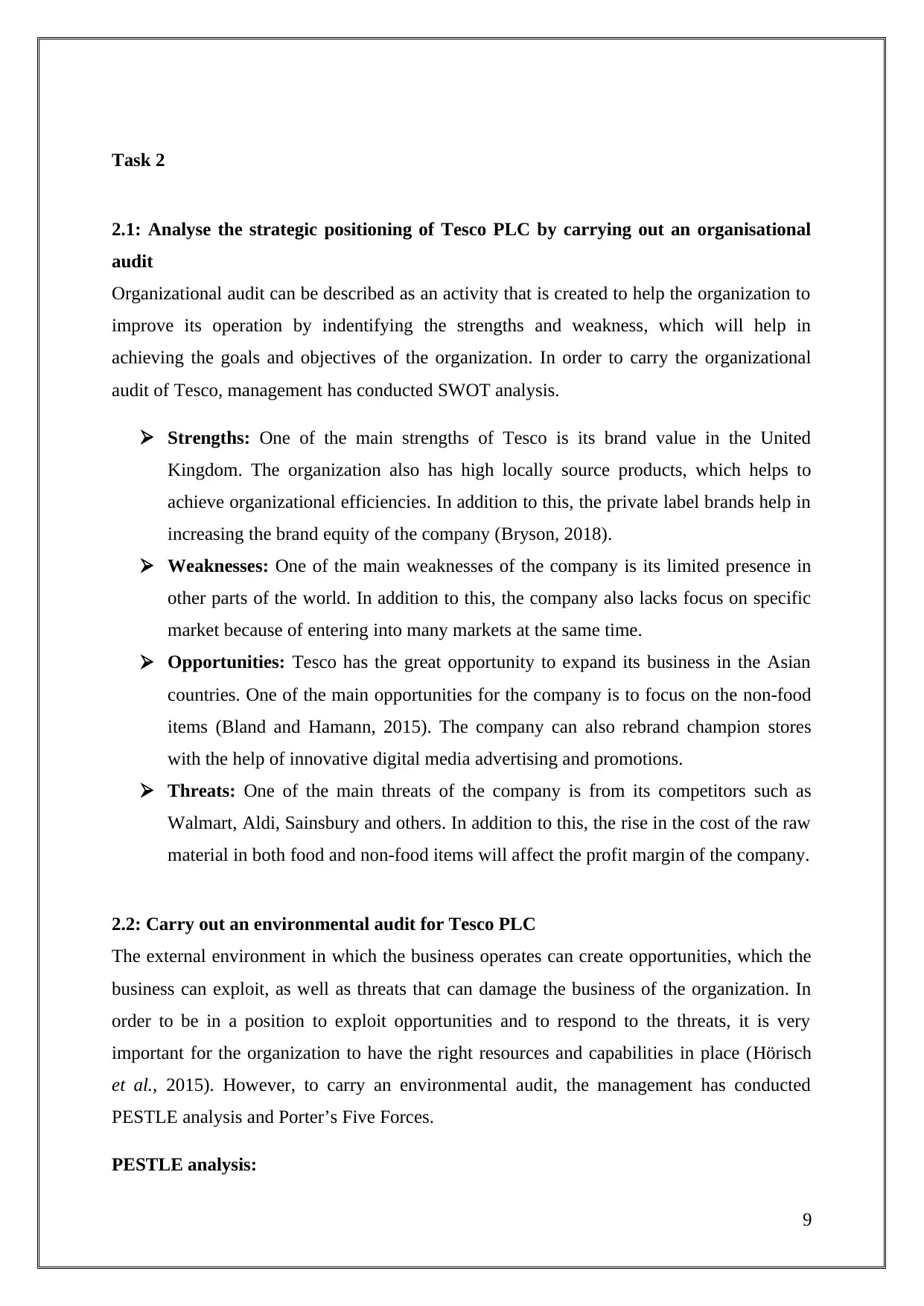
Task 2
2.1: Analyse the strategic positioning of Tesco PLC by carrying out an organisational
audit
Organizational audit can be described as an activity that is created to help the organization to
improve its operation by indentifying the strengths and weakness, which will help in
achieving the goals and objectives of the organization. In order to carry the organizational
audit of Tesco, management has conducted SWOT analysis.
Strengths: One of the main strengths of Tesco is its brand value in the United
Kingdom. The organization also has high locally source products, which helps to
achieve organizational efficiencies. In addition to this, the private label brands help in
increasing the brand equity of the company (Bryson, 2018).
Weaknesses: One of the main weaknesses of the company is its limited presence in
other parts of the world. In addition to this, the company also lacks focus on specific
market because of entering into many markets at the same time.
Opportunities: Tesco has the great opportunity to expand its business in the Asian
countries. One of the main opportunities for the company is to focus on the non-food
items (Bland and Hamann, 2015). The company can also rebrand champion stores
with the help of innovative digital media advertising and promotions.
Threats: One of the main threats of the company is from its competitors such as
Walmart, Aldi, Sainsbury and others. In addition to this, the rise in the cost of the raw
material in both food and non-food items will affect the profit margin of the company.
2.2: Carry out an environmental audit for Tesco PLC
The external environment in which the business operates can create opportunities, which the
business can exploit, as well as threats that can damage the business of the organization. In
order to be in a position to exploit opportunities and to respond to the threats, it is very
important for the organization to have the right resources and capabilities in place (Hörisch
et al., 2015). However, to carry an environmental audit, the management has conducted
PESTLE analysis and Porter’s Five Forces.
PESTLE analysis:
9
2.1: Analyse the strategic positioning of Tesco PLC by carrying out an organisational
audit
Organizational audit can be described as an activity that is created to help the organization to
improve its operation by indentifying the strengths and weakness, which will help in
achieving the goals and objectives of the organization. In order to carry the organizational
audit of Tesco, management has conducted SWOT analysis.
Strengths: One of the main strengths of Tesco is its brand value in the United
Kingdom. The organization also has high locally source products, which helps to
achieve organizational efficiencies. In addition to this, the private label brands help in
increasing the brand equity of the company (Bryson, 2018).
Weaknesses: One of the main weaknesses of the company is its limited presence in
other parts of the world. In addition to this, the company also lacks focus on specific
market because of entering into many markets at the same time.
Opportunities: Tesco has the great opportunity to expand its business in the Asian
countries. One of the main opportunities for the company is to focus on the non-food
items (Bland and Hamann, 2015). The company can also rebrand champion stores
with the help of innovative digital media advertising and promotions.
Threats: One of the main threats of the company is from its competitors such as
Walmart, Aldi, Sainsbury and others. In addition to this, the rise in the cost of the raw
material in both food and non-food items will affect the profit margin of the company.
2.2: Carry out an environmental audit for Tesco PLC
The external environment in which the business operates can create opportunities, which the
business can exploit, as well as threats that can damage the business of the organization. In
order to be in a position to exploit opportunities and to respond to the threats, it is very
important for the organization to have the right resources and capabilities in place (Hörisch
et al., 2015). However, to carry an environmental audit, the management has conducted
PESTLE analysis and Porter’s Five Forces.
PESTLE analysis:
9
⊘ This is a preview!⊘
Do you want full access?
Subscribe today to unlock all pages.

Trusted by 1+ million students worldwide
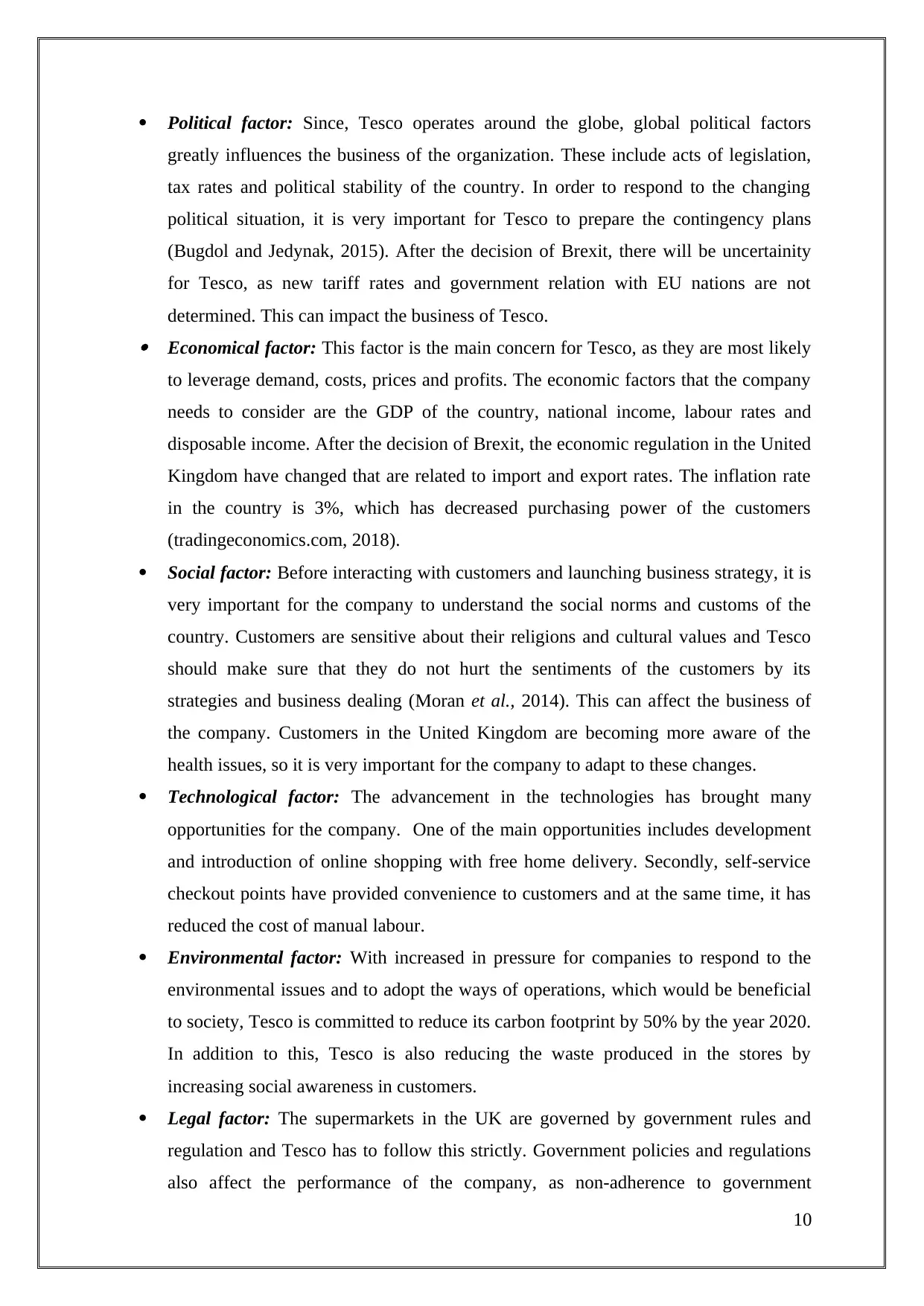
Political factor: Since, Tesco operates around the globe, global political factors
greatly influences the business of the organization. These include acts of legislation,
tax rates and political stability of the country. In order to respond to the changing
political situation, it is very important for Tesco to prepare the contingency plans
(Bugdol and Jedynak, 2015). After the decision of Brexit, there will be uncertainity
for Tesco, as new tariff rates and government relation with EU nations are not
determined. This can impact the business of Tesco. Economical factor: This factor is the main concern for Tesco, as they are most likely
to leverage demand, costs, prices and profits. The economic factors that the company
needs to consider are the GDP of the country, national income, labour rates and
disposable income. After the decision of Brexit, the economic regulation in the United
Kingdom have changed that are related to import and export rates. The inflation rate
in the country is 3%, which has decreased purchasing power of the customers
(tradingeconomics.com, 2018).
Social factor: Before interacting with customers and launching business strategy, it is
very important for the company to understand the social norms and customs of the
country. Customers are sensitive about their religions and cultural values and Tesco
should make sure that they do not hurt the sentiments of the customers by its
strategies and business dealing (Moran et al., 2014). This can affect the business of
the company. Customers in the United Kingdom are becoming more aware of the
health issues, so it is very important for the company to adapt to these changes.
Technological factor: The advancement in the technologies has brought many
opportunities for the company. One of the main opportunities includes development
and introduction of online shopping with free home delivery. Secondly, self-service
checkout points have provided convenience to customers and at the same time, it has
reduced the cost of manual labour.
Environmental factor: With increased in pressure for companies to respond to the
environmental issues and to adopt the ways of operations, which would be beneficial
to society, Tesco is committed to reduce its carbon footprint by 50% by the year 2020.
In addition to this, Tesco is also reducing the waste produced in the stores by
increasing social awareness in customers.
Legal factor: The supermarkets in the UK are governed by government rules and
regulation and Tesco has to follow this strictly. Government policies and regulations
also affect the performance of the company, as non-adherence to government
10
greatly influences the business of the organization. These include acts of legislation,
tax rates and political stability of the country. In order to respond to the changing
political situation, it is very important for Tesco to prepare the contingency plans
(Bugdol and Jedynak, 2015). After the decision of Brexit, there will be uncertainity
for Tesco, as new tariff rates and government relation with EU nations are not
determined. This can impact the business of Tesco. Economical factor: This factor is the main concern for Tesco, as they are most likely
to leverage demand, costs, prices and profits. The economic factors that the company
needs to consider are the GDP of the country, national income, labour rates and
disposable income. After the decision of Brexit, the economic regulation in the United
Kingdom have changed that are related to import and export rates. The inflation rate
in the country is 3%, which has decreased purchasing power of the customers
(tradingeconomics.com, 2018).
Social factor: Before interacting with customers and launching business strategy, it is
very important for the company to understand the social norms and customs of the
country. Customers are sensitive about their religions and cultural values and Tesco
should make sure that they do not hurt the sentiments of the customers by its
strategies and business dealing (Moran et al., 2014). This can affect the business of
the company. Customers in the United Kingdom are becoming more aware of the
health issues, so it is very important for the company to adapt to these changes.
Technological factor: The advancement in the technologies has brought many
opportunities for the company. One of the main opportunities includes development
and introduction of online shopping with free home delivery. Secondly, self-service
checkout points have provided convenience to customers and at the same time, it has
reduced the cost of manual labour.
Environmental factor: With increased in pressure for companies to respond to the
environmental issues and to adopt the ways of operations, which would be beneficial
to society, Tesco is committed to reduce its carbon footprint by 50% by the year 2020.
In addition to this, Tesco is also reducing the waste produced in the stores by
increasing social awareness in customers.
Legal factor: The supermarkets in the UK are governed by government rules and
regulation and Tesco has to follow this strictly. Government policies and regulations
also affect the performance of the company, as non-adherence to government
10
Paraphrase This Document
Need a fresh take? Get an instant paraphrase of this document with our AI Paraphraser
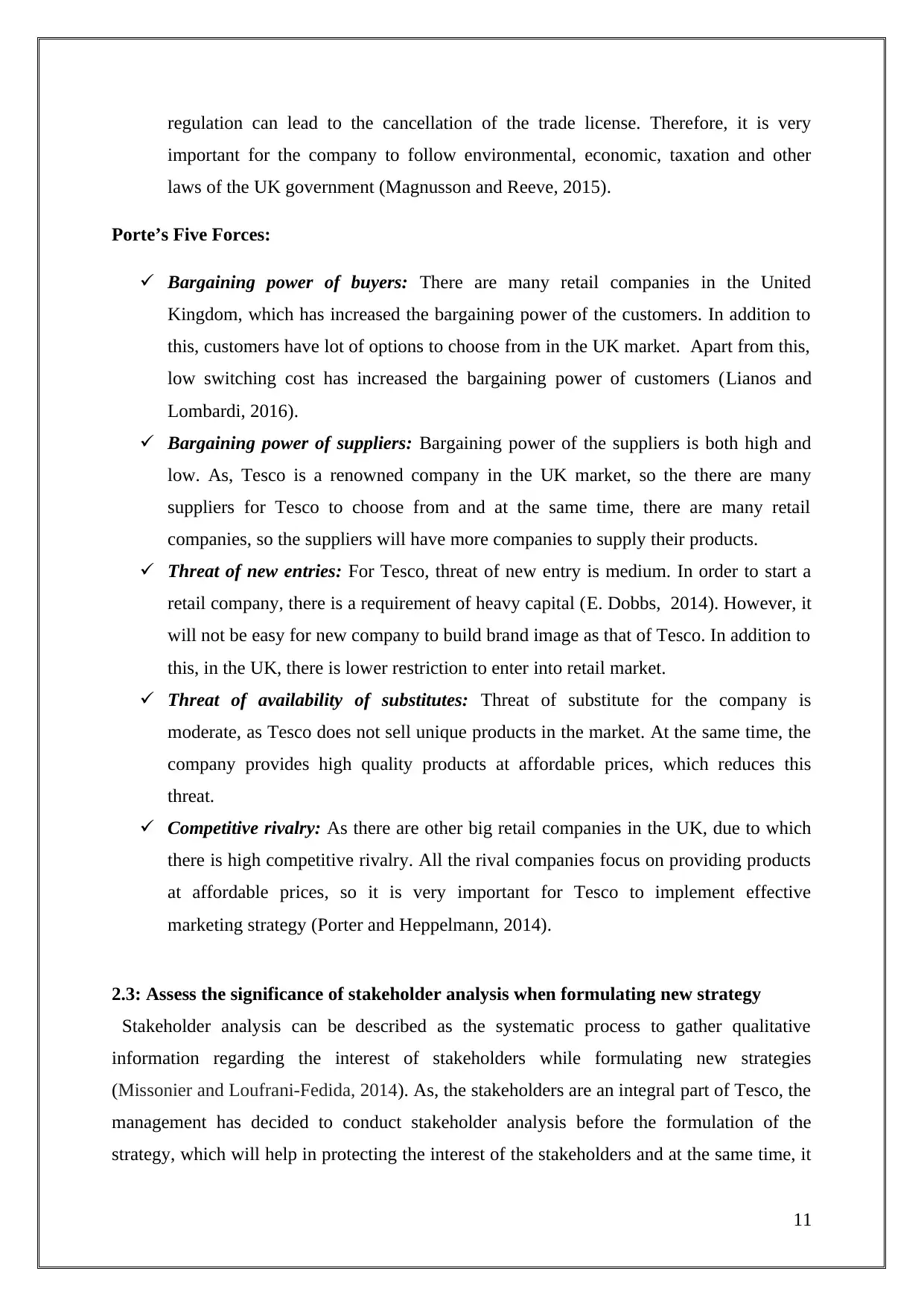
regulation can lead to the cancellation of the trade license. Therefore, it is very
important for the company to follow environmental, economic, taxation and other
laws of the UK government (Magnusson and Reeve, 2015).
Porte’s Five Forces:
Bargaining power of buyers: There are many retail companies in the United
Kingdom, which has increased the bargaining power of the customers. In addition to
this, customers have lot of options to choose from in the UK market. Apart from this,
low switching cost has increased the bargaining power of customers (Lianos and
Lombardi, 2016).
Bargaining power of suppliers: Bargaining power of the suppliers is both high and
low. As, Tesco is a renowned company in the UK market, so the there are many
suppliers for Tesco to choose from and at the same time, there are many retail
companies, so the suppliers will have more companies to supply their products.
Threat of new entries: For Tesco, threat of new entry is medium. In order to start a
retail company, there is a requirement of heavy capital (E. Dobbs, 2014). However, it
will not be easy for new company to build brand image as that of Tesco. In addition to
this, in the UK, there is lower restriction to enter into retail market.
Threat of availability of substitutes: Threat of substitute for the company is
moderate, as Tesco does not sell unique products in the market. At the same time, the
company provides high quality products at affordable prices, which reduces this
threat.
Competitive rivalry: As there are other big retail companies in the UK, due to which
there is high competitive rivalry. All the rival companies focus on providing products
at affordable prices, so it is very important for Tesco to implement effective
marketing strategy (Porter and Heppelmann, 2014).
2.3: Assess the significance of stakeholder analysis when formulating new strategy
Stakeholder analysis can be described as the systematic process to gather qualitative
information regarding the interest of stakeholders while formulating new strategies
(Missonier and Loufrani-Fedida, 2014). As, the stakeholders are an integral part of Tesco, the
management has decided to conduct stakeholder analysis before the formulation of the
strategy, which will help in protecting the interest of the stakeholders and at the same time, it
11
important for the company to follow environmental, economic, taxation and other
laws of the UK government (Magnusson and Reeve, 2015).
Porte’s Five Forces:
Bargaining power of buyers: There are many retail companies in the United
Kingdom, which has increased the bargaining power of the customers. In addition to
this, customers have lot of options to choose from in the UK market. Apart from this,
low switching cost has increased the bargaining power of customers (Lianos and
Lombardi, 2016).
Bargaining power of suppliers: Bargaining power of the suppliers is both high and
low. As, Tesco is a renowned company in the UK market, so the there are many
suppliers for Tesco to choose from and at the same time, there are many retail
companies, so the suppliers will have more companies to supply their products.
Threat of new entries: For Tesco, threat of new entry is medium. In order to start a
retail company, there is a requirement of heavy capital (E. Dobbs, 2014). However, it
will not be easy for new company to build brand image as that of Tesco. In addition to
this, in the UK, there is lower restriction to enter into retail market.
Threat of availability of substitutes: Threat of substitute for the company is
moderate, as Tesco does not sell unique products in the market. At the same time, the
company provides high quality products at affordable prices, which reduces this
threat.
Competitive rivalry: As there are other big retail companies in the UK, due to which
there is high competitive rivalry. All the rival companies focus on providing products
at affordable prices, so it is very important for Tesco to implement effective
marketing strategy (Porter and Heppelmann, 2014).
2.3: Assess the significance of stakeholder analysis when formulating new strategy
Stakeholder analysis can be described as the systematic process to gather qualitative
information regarding the interest of stakeholders while formulating new strategies
(Missonier and Loufrani-Fedida, 2014). As, the stakeholders are an integral part of Tesco, the
management has decided to conduct stakeholder analysis before the formulation of the
strategy, which will help in protecting the interest of the stakeholders and at the same time, it
11
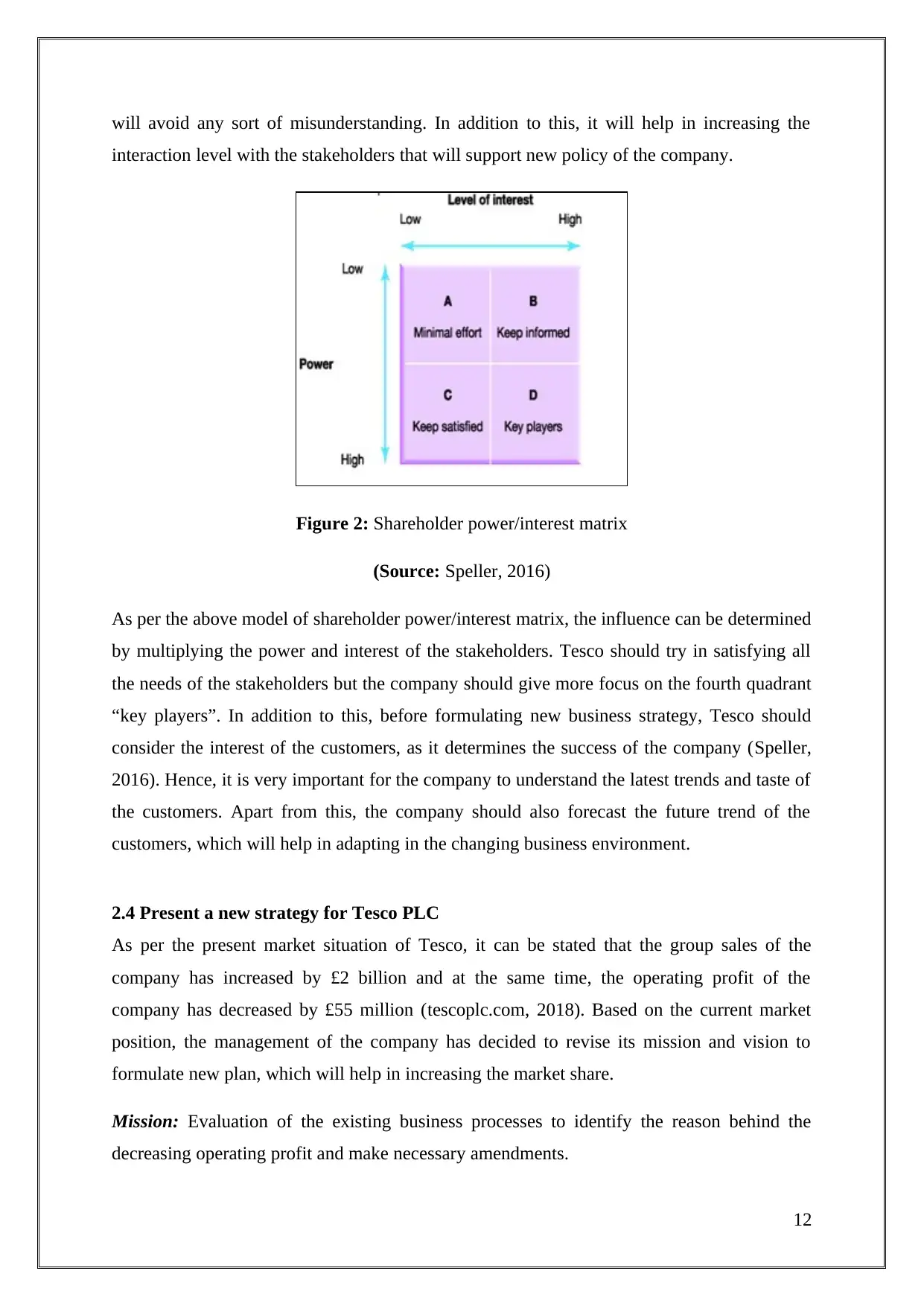
will avoid any sort of misunderstanding. In addition to this, it will help in increasing the
interaction level with the stakeholders that will support new policy of the company.
Figure 2: Shareholder power/interest matrix
(Source: Speller, 2016)
As per the above model of shareholder power/interest matrix, the influence can be determined
by multiplying the power and interest of the stakeholders. Tesco should try in satisfying all
the needs of the stakeholders but the company should give more focus on the fourth quadrant
“key players”. In addition to this, before formulating new business strategy, Tesco should
consider the interest of the customers, as it determines the success of the company (Speller,
2016). Hence, it is very important for the company to understand the latest trends and taste of
the customers. Apart from this, the company should also forecast the future trend of the
customers, which will help in adapting in the changing business environment.
2.4 Present a new strategy for Tesco PLC
As per the present market situation of Tesco, it can be stated that the group sales of the
company has increased by £2 billion and at the same time, the operating profit of the
company has decreased by £55 million (tescoplc.com, 2018). Based on the current market
position, the management of the company has decided to revise its mission and vision to
formulate new plan, which will help in increasing the market share.
Mission: Evaluation of the existing business processes to identify the reason behind the
decreasing operating profit and make necessary amendments.
12
interaction level with the stakeholders that will support new policy of the company.
Figure 2: Shareholder power/interest matrix
(Source: Speller, 2016)
As per the above model of shareholder power/interest matrix, the influence can be determined
by multiplying the power and interest of the stakeholders. Tesco should try in satisfying all
the needs of the stakeholders but the company should give more focus on the fourth quadrant
“key players”. In addition to this, before formulating new business strategy, Tesco should
consider the interest of the customers, as it determines the success of the company (Speller,
2016). Hence, it is very important for the company to understand the latest trends and taste of
the customers. Apart from this, the company should also forecast the future trend of the
customers, which will help in adapting in the changing business environment.
2.4 Present a new strategy for Tesco PLC
As per the present market situation of Tesco, it can be stated that the group sales of the
company has increased by £2 billion and at the same time, the operating profit of the
company has decreased by £55 million (tescoplc.com, 2018). Based on the current market
position, the management of the company has decided to revise its mission and vision to
formulate new plan, which will help in increasing the market share.
Mission: Evaluation of the existing business processes to identify the reason behind the
decreasing operating profit and make necessary amendments.
12
⊘ This is a preview!⊘
Do you want full access?
Subscribe today to unlock all pages.

Trusted by 1+ million students worldwide
1 out of 23
Related Documents
Your All-in-One AI-Powered Toolkit for Academic Success.
+13062052269
info@desklib.com
Available 24*7 on WhatsApp / Email
![[object Object]](/_next/static/media/star-bottom.7253800d.svg)
Unlock your academic potential
Copyright © 2020–2025 A2Z Services. All Rights Reserved. Developed and managed by ZUCOL.





